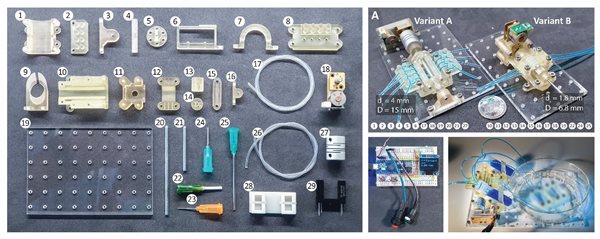SUTD researchers developed DIY 3D-printed peristaltic pump kits for microfluidics
NUS - Yi-Chin Toh, Hsih Yin Tan and Chwee Teck Lim
SUTD researchers developed a highly-customisable, 3D-printed peristaltic pump kit where users from around the world can download the design files, 3D-print and assemble their do-it-yourself peristaltic pump.
 To make microfluidic pumps more accessible to the scientific community, SUTD researchers developed a highly-customisable, 3D-printed peristaltic pump kit, where users from around the world can download the design files, 3D-print and assemble their do-it-yourself peristaltic pump.
To make microfluidic pumps more accessible to the scientific community, SUTD researchers developed a highly-customisable, 3D-printed peristaltic pump kit, where users from around the world can download the design files, 3D-print and assemble their do-it-yourself peristaltic pump.
The development of microfluidic systems for lab-on-a-chip (LoC) and organs-on-a-chip (OoC) applications require precise fluid flow control. Typically, on-chip flows are controlled by integrating a microfluidic chip with external pumps that deliver fluid flow at the microscale (typically on the order of mL/min) through the microchannels. To this end, commercially available flow devices such as extrusion syringe pumps, peristaltic pumps and pneumatic pumps have been widely used.
Unfortunately, existing pumps suitable for microfluidic applications are usually bulky and costly. For example, pressure-controlled flow systems cost as much as US$10,000, whereas syringe pumps and peristaltic pumps cost hundreds to thousands of dollars. Pumps with a small footprint are preferred for LoC and OoC applications. While miniature pumps are commercially available, they require proprietary and expensive control systems (over US$1,000). More importantly, these commercially available pumps are not amenable to customisation. Since each experiment has unique requirements such as flowrate, working environment, and available space, rapid customisation of the instrument would benefit users.
To make microfluidic pumps more accessible to the scientific community, researchers from the Singapore University of Technology and Design (SUTD) Soft Fluidics Lab developed a “highly-customisable, 3D-printed peristaltic pump kit”, where users from around the world can download the design files, 3D-print and assemble their do-it-yourself (DIY) peristaltic pump.
“3D printers have become more and more affordable, and they are a commodity that is found in most scientific laboratories today. With the advancement of 3D printing technologies, scientists no longer have to rely on manufacturers to manufacture components; they can design and print them themselves at an affordable cost. We are slowly observing the democratisation of manufacturing by 3D printing technology,” said Associate Professor Michinao Hashimoto, the project’s principal investigator from SUTD.
The peristaltic pump is powered and controlled by Arduino, an open-source electronics platform. “With the introduction of Arduino, precise control of motors is becoming accessible to non-experts. These open-source electronic platforms are empowering scientists with little background in electronics and programming to build complex scientific instrumentations,” explained lead author Terry Ching, a joint graduate student with SUTD and National University of Singapore (NUS).
By combining 3D-printed parts with open-source electronic prototyping platforms, the team built a peristaltic pump comparable to commercially available options at a fraction of the cost, an estimated US$50 per pump. The assembled pumps offered a wide range of flowrate for microfluidic users (0.02 - 727.3 μL/min). The pump also has a small footprint of around 20 × 50 × 28 mm, which can be placed in a cell incubator. Notably, the pump is designed in the form of a kit, allowing end-users to customise the setup according to their preference.
“We believe that a kit has the intrinsic ability to evoke the culture of hacking and tinkering. Hopefully, this can in turn inspire the scientific community to develop more open-source scientific infrastructure,” added Professor Hashimoto.
Computer-aided design (CAD) files with detailed instructions to fabricate the pump is found in their latest publication, 'Highly-customisable 3D-printed peristaltic pump kit' in HardwareX. This research was conducted in collaboration with the research groups of Professor Yi-Chin Toh (Queensland University of Technology), Associate Professor Javier Fernandez (SUTD) and Professor Chwee Teck Lim (National University of Singapore).
Acknowledgements:
T.C. acknowledges Jose Gomez-Marquez, Anna K. Young, and Grace Teo from Massachusetts Institute of Technology ( MIT ) for the instruction of the course titled HST.S47 Construction Sets for Health. T.C. thanks Ministry of Education ( MOE ), Singapore, for awarding the President's Graduate Fellowship. M.H. thanks Agency for Science, Technology and Research (A*STAR) for the support to the project (A19B9b0067), and Digital Manufacturing and Design Center (DManD Center) at Singapore University of Technology and Design for the use of shared equipment (RGDM1620503).
Reference:
Highly-customizable 3D-printed peristaltic pump kit, HardwareX. (DOI: 10.1016/j.ohx.2021.e00202)